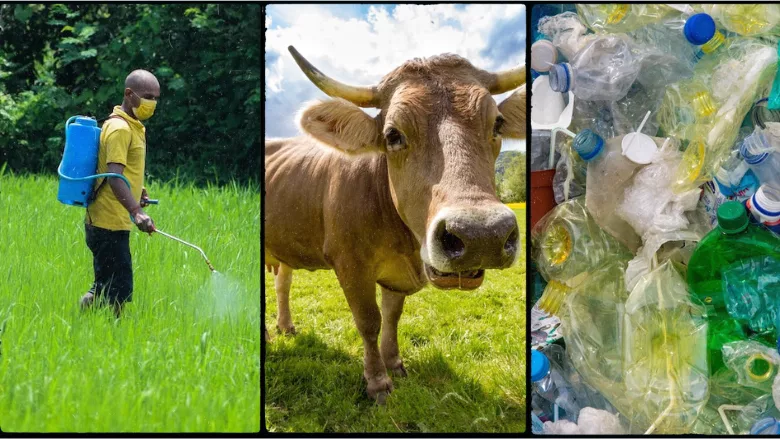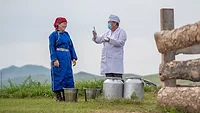FAO Explores Food Safety Risks of Pesticides, Veterinary Drugs, Microplastics on Gut Microbiome

Image credit: Prakash Aryal, Pixabay, and Magda Ehlers via Pexels
The Food and Agriculture Organization of the United Nations (FAO) has published the results of an extensive literature review examining the effects of consuming three pervasive, chemical food contaminants—pesticide residues, veterinary drug residues, and microplastics—on the human gut microbiome. The literature reviews aim to fill existing knowledge gaps about how dietary components can impact the gut microbiome and human health, which is crucial information to improve food safety risk assessment.
Food safety was the central focus of the three reviews, which identify research limitations, knowledge gaps, and areas that need further investigation before using gut microbiome data in chemical evaluations and in the advancement of food safety risk assessment. The reviews can serve as a starting point for multidisciplinary discussions with risk assessors to support regulatory science and policy development.
Although the available literature, and therefore FAO’s conclusions and recommendations, are much more extensive regarding pesticide residues than veterinary drug residues or microplastics, all three reviews point to the ability of their respective chemical contaminants to alter the human guy microbiome and necessitate further research.
The Gut Microbiome
The gut microbiome is highly dynamic and complex microbial community that resides and interacts within the gastrointestinal (GI) tract. These communities can take part in various physiological activities, such as digestion and immune function, and help maintain intestinal and systemic homeostasis. In addition, the gut microbiome is very sensitive to environmental factors, including diet, which can have both positive and negative impacts on health. Imbalances of the gut microbiome have been associated with various disorders, including obesity, diabetes, and inflammatory bowel disease. With the advent of “omics” technologies, the study of the gut microbiome has taken a holistic approach, allowing for a deeper understanding of the complex interactions between the microbiome and the host.
Pesticide Residues
FAO’s literature review of the effects of pesticide residues on the gut microbiome included rodent studies, which revealed alterations of the gut microbiome and the animals’ homeostasis in the vast majority of cases, with limited demonstration of causality. A few in vitro studies also showed microbial disturbances. However, assessing the relevance of these findings remains challenging in the absence of a defined healthy microbiome and dysbiosis. Additional research and guidance are needed to 1) establish causality and the involved mechanisms, 2) investigate the impact of low-level pesticide residues in the microbiome, and 3) consider the gut microbiome in pesticide residue risk assessment.
The report included four major recommendations. The first is to organize a series of meetings involving risk assessors and multidisciplinary microbiome experts to:
- Provide definitions for healthy microbiome and dysbiosis in the context of risk assessment
- Discuss the gaps and limitations of the microbiome as a potential component of chemical safety assessments and provide recommendations for research activities
- Identify suitable microbiome-related parameters and endpoints with pathophysiological relevance
- Update existing assessment processes and set criteria to include and evaluate microbiome-derived data, including those generated from omics technologies
- Develop a guideline to support risk assessors in evaluating and interpreting gut microbiome-derived data.
FAO also recommends research activities that investigate the gut microbiome’s involvement in the chemical transformation of pesticides, and changes in the compound toxicokinetics and toxicity; chronic exposure to low-level pesticide residues; pesticide co-exposure and evaluation of pesticide co-formulants; and demonstration of causality and involved mechanisms. Additionally, FAO recommends joining and contributing to the efforts of the scientific community that aim to establish suitable models for microbiome research, standardize in vivo and in vitro methods used to evaluate the safety of pesticide residues and other chemicals of relevance to food safety, and standardize analytical methodologies including those based on omics technologies.
Finally, FAO recommends developing guidelines for scientists to help harmonize microbiome studies and ensure data quality, covering areas such as:
- Selection criteria for animal and in vitro models
- Determination of appropriate sample size (i.e., number of animals per treatment group) and sampling frequency
- Selection of suitable human microbiota donors, sample collection, and sample handling for in vitro studies
- Criteria for selecting pesticide doses (e.g., based on existing health-based reference values) and minimum exposure times
- Criteria for selecting primers for evaluating the 16S rRNA gene amplification
- Guidance for statistical analysis.
Veterinary Drug Residues
FAO found that the study of veterinary drug residues on the gut microbiome is limited, with only a few studies addressing the impact of chronic exposure to low-level concentrations. Most studies have been conducted in vitro and are highly dependent on traditional bacteria cultures of select or representative gut bacterial species.
Looking for quick answers on food safety topics?
Try Ask FSM, our new smart AI search tool.
Ask FSM →
Although analytical omics approaches have been used to characterize changes in the composition and function of the microbiome after exposure to sub-doses or therapeutic doses of pharmaceuticals, such techniques have not been widely used to evaluate the effects of residual levels. Because of the nature of in vitro studies used to assess veterinary drug residues, it is difficult to evaluate the potential impact of gut microbiome disturbances on human health and non-communicable diseases.
Furthermore, current microbiological endpoints used to assess the safety of dietary veterinary drug residues focus on evaluating the impact of the substances on the GI barrier and the development of resistance in the human gut microbiome. At present, there are no endpoints defined beyond the GI tract.
Additionally, most studies on physiopathological interactions between drugs and the host microbiome have mainly shown associations, but not causality or mechanisms. In most studies, it is difficult to evaluate whether alterations of the microbiome and host physiology after drug exposure are parallel effects, if the microbiome changes induce disruptions in the host homeostasis, or if the microbiome is altered by the host’s response to veterinary drug residues.
Therefore, the actual contribution and extent of such contribution of the gut microbiome to health and disease remains an important challenge to be addressed with more research. More research is also required to investigate the potential long-term negative impact of veterinary drug residues on the human gut microbiome and the consequent influence on human health.
Microplastics
Just as for veterinary drug residues, the number of available studies evaluating the impact of microplastics on the gut microbiota is very limited. However, available research discussed in FAO’s review shows that microplastics induce alterations in the gut microbiota of all animal models. Still, the characteristics of such microbial disturbances varied from study to study.
Variances are partly explained by the heterogeneity of experimental designs, such as the animal models used and microplastics type, sizes, shapes, and doses, as well as the lack of standardized analytical methods and microplastics reference materials, making inter-study comparisons and drawing conclusions challenging.
In studies, the microbiotas of aquatic animals were evaluated as an endpoint parallel to the analysis of other parameters in the host. The effects of microplastics on the host were limited to the intestinal tract in most cases. Observations after microplastics exposure included altered intestinal structure and function, gut inflammation, and increased oxidative stress. Additionally, microplastics were able to induce alterations in lipid and energy metabolism in rodents.
Although based on very limited number of studies, the effects are dose-, size-, and shape-dependent. While some authors speculated the potential role of the altered microbiome in the development of metabolic alterations, they did not support the possibility with scientific evidence. The biological relevance of the microbial alterations described in the studies is also unclear.








